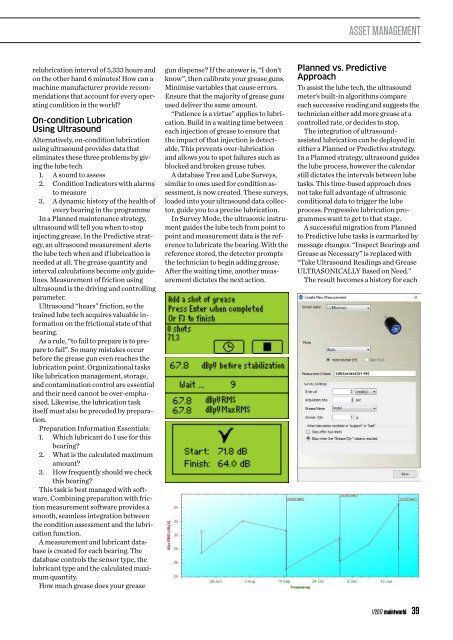Maintworld 1/2017
You also want an ePaper? Increase the reach of your titles
YUMPU automatically turns print PDFs into web optimized ePapers that Google loves.
!<br />
!<br />
!<br />
• Say what you’re going to do<br />
ASSET MANAGEMENT<br />
g to do<br />
relubrication interval of 5,333 hours and<br />
on the other hand 6 minutes! How can a<br />
machine manufacturer provide recommendations<br />
that account for every operating<br />
condition in the world?<br />
• Say what you’re going to do<br />
On-condition Lubrication<br />
Using Ultrasound<br />
Alternatively, on-condition lubrication<br />
using ultrasound provides data that<br />
eliminates these three problems by giving<br />
the lube tech<br />
1. A sound to assess<br />
2. Condition Indicators with alarms<br />
to measure<br />
3. A dynamic history of the health of<br />
every bearing in the programme<br />
In a Planned maintenance strategy,<br />
ultrasound will tell you when to stop<br />
injecting grease. In the Predictive strategy,<br />
an ultrasound measurement alerts<br />
the lube tech when and if lubrication is<br />
needed at all. The grease quantity and<br />
interval calculations become only guidelines.<br />
Measurement of friction using<br />
ultrasound is the driving and controlling<br />
parameter.<br />
Ultrasound “hears” friction, so the<br />
trained lube tech acquires valuable information<br />
on the frictional state of that<br />
bearing.<br />
As a rule, “to fail to prepare is to prepare<br />
to fail”. So many mistakes occur<br />
before the grease gun even reaches the<br />
lubrication point. Organizational tasks<br />
like lubrication management, storage,<br />
and contamination control are essential<br />
and their need cannot be over-emphasised.<br />
Likewise, the lubrication task<br />
itself must also be preceded by preparation.<br />
Preparation Information Essentials:<br />
1. Which lubricant do I use for this<br />
bearing?<br />
2. What is the calculated maximum<br />
amount?<br />
3. How frequently should we check<br />
this bearing?<br />
This task is best managed with software.<br />
Combining preparation with friction<br />
measurement software provides a<br />
smooth, seamless integration between<br />
the condition assessment and the lubrication<br />
function.<br />
A measurement and lubricant database<br />
is created for each bearing. The<br />
database controls the sensor type, the<br />
lubricant type and the calculated maximum<br />
quantity.<br />
How much grease does your grease<br />
gun dispense? If the answer is, “I don’t<br />
know”, then calibrate your grease guns.<br />
Minimise variables that cause errors.<br />
Ensure that the majority of grease guns<br />
used deliver the same amount.<br />
“Patience is a virtue” applies to lubrication.<br />
Build in a waiting time between<br />
each injection of grease to ensure that<br />
the impact of that injection is detectable.<br />
This prevents over-lubrication<br />
and allows you to spot failures such as<br />
blocked and broken grease tubes.<br />
A database Tree and Lube Surveys,<br />
similar to ones used for condition assessment,<br />
is now created. These surveys,<br />
loaded into your ultrasound data collector,<br />
guide you to a precise lubrication.<br />
In Survey Mode, the ultrasonic instrument<br />
guides the lube tech from point to<br />
point and measurement data is the reference<br />
to lubricate the bearing. With the<br />
reference stored, the detector prompts<br />
the technician to begin adding grease.<br />
After the waiting time, another measurement<br />
dictates the next action.<br />
• Say what you’re going to do<br />
Planned vs. Predictive<br />
Approach<br />
To assist the lube tech, the ultrasound<br />
meter’s built-in algorithms compare<br />
each successive reading and suggests the<br />
technician either add more grease at a<br />
controlled rate, or decides to stop.<br />
The integration of ultrasoundassisted<br />
lubrication can be deployed in<br />
either a Planned or Predictive strategy.<br />
In a Planned strategy, ultrasound guides<br />
the lube process, however the calendar<br />
still dictates the intervals between lube<br />
tasks. This time-based approach does<br />
not take full advantage of ultrasonic<br />
conditional data to trigger the lube<br />
process. Progressive lubrication programmes<br />
want to get to that stage.<br />
A successful migration from Planned<br />
to Predictive lube tasks is earmarked by<br />
message changes. “Inspect Bearings and<br />
Grease as Necessary” is replaced with<br />
“Take Ultrasound Readings and Grease<br />
ULTRASONICALLY Based on Need.”<br />
The result becomes a history for each<br />
1/<strong>2017</strong> maintworld 39

















